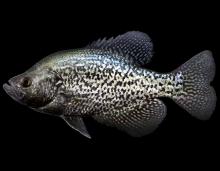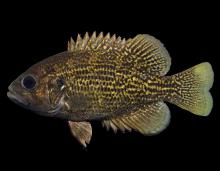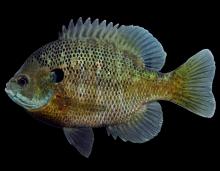Fishes
Media

Species Types
Scientific Name
Esox lucius
Description
The largest pike native to Missouri, the northern pike can be more than 4 feet long and weigh more than 40 pounds. Missouri is on the southern edge of the range of this species. Because of its rarity here, it is of little importance as a game fish.
Media

Species Types
Scientific Name
Amia ocellicauda (formerly Amia calva)
Description
The eyetail bowfin is a stout-bodied, nearly cylindrical fish. It is most abundant in the Mississippi Lowlands, though it occurs along the entire length of the Mississippi River.
Media

Species Types
Scientific Name
Lepomis cyanellus
Description
The green sunfish is thick-bodied with a large mouth. The upper jaw extends to about the middle of the eye. It may occur in just about any pond, lake, or stream that is capable of supporting fish life.
Media

Species Types
Scientific Name
Pomoxis annularis
Description
The white crappie, a popular panfish, has silver sides with 5 to 10 often faint vertical bars. The upper jaw reaches past the middle of the eye. It is more abundant and widespread than the black crappie.
Media

Species Types
Scientific Name
Pomoxis nigromaculatus
Description
The black crappie is a popular panfish. It is deep bodied and slab sided. The sides are silver with an irregular pattern of dark speckles. The upper jaw is long, reaching past the middle of the eye.
Media

Species Types
Scientific Name
Centrarchus macropterus
Description
The flier is found in Missouri's southeastern lowland swamps. It resembles crappie but has 10-13 dorsal spines. It's deep-bodied and saucer-shaped and generally olive-green to brassy in color.
Media

Species Types
Scientific Name
Lepomis megalotis
Description
The longear sunfish is deep-bodied, slab-sided, with a moderate-sized mouth, the upper jaw nearly reaching the front of the eye. It is by far the most abundant and generally distributed sunfish over the southern half of Missouri.
Media

Species Types
Scientific Name
Ambloplites rupestris
Description
The northern rock bass, or goggle-eye, is thicker than most other sunfish, with a large mouth and very large eyes. It occurs in northern Ozark streams, tributaries of the middle Mississippi, and a portion of the southwestern Ozarks; sometimes in Ozark reservoirs.
Media

Species Types
Scientific Name
Lepomis macrochirus
Description
The bluegill is one of the most abundant and popular panfishes in North America. This deep-bodied, slab-sided sunfish sports a black “ear flap” extending from the edge of its gill cover.
Media

Species Types
Scientific Name
Micropterus punctulatus
Description
The spotted bass inhabits permanent-flowing waters that are warmer and slightly more turbid than those where the smallmouth bass occurs. Note the form of its stripe and the length of its jaw.
See Also


Media

Species Types
Scientific Name
Amphiuma tridactylum
Description
The three-toed amphiuma is an eel-like, completely aquatic salamander. It has very small forelimbs and hind limbs, each with three tiny toes. In Missouri it’s found only in the Bootheel region.
Media

Species Types
Scientific Name
Siren intermedia nettingi
Description
The western lesser siren is an eel-like, aquatic salamander with external gills, small eyes, small forelimbs with four toes, and no hind limbs. In Missouri, it’s found mostly in the Bootheel and northward in counties near the Mississippi River.
About Fishes in Missouri
Missouri has more than 200 kinds of fish, more than are found in most neighboring states. Fishes live in water, breathe with gills, and have fins instead of legs. Most are covered with scales. Most fish in Missouri “look” like fish and could never be confused with anything else. True, lampreys and eels have snakelike bodies — but they also have fins and smooth, slimy skin, which snakes do not.





















